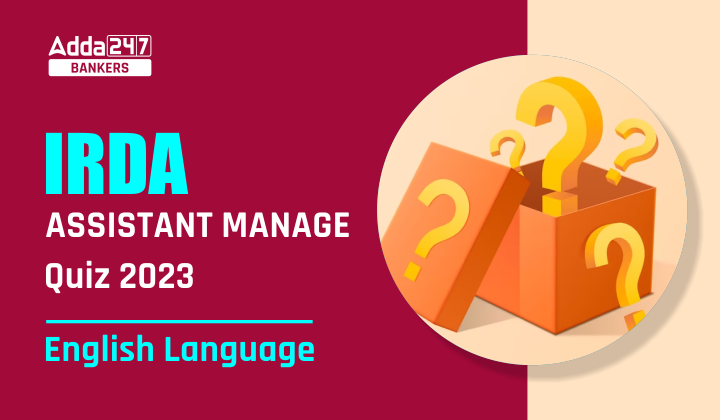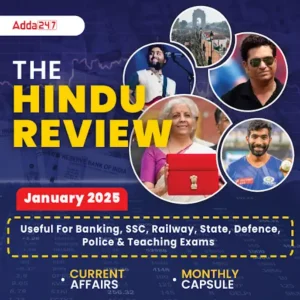Directions (1-8): In the following given passage, certain words are highlighted which may or may not be fit in the sentence either grammatically or contextually. Each word is numbered followed by four possible replacements. If none of the possible replacements could replace the highlighted word, mark your answer, (e); “None of the above”.
Q1. Finance Minister Nirmala Sitharaman, in the Union Budget speech, introduced the proposal and stated that those States that fully rhetoric (1) the facilities of the hospital to the medical college and wish to provide land at a concession would be eligible for viability gap funding. Several details are already available in the public ominous (2), as part of the plan, first proposed by NITI Aayog. It argues that it is practically not possible for Central and State governments to bridge the gaps in medical education with their limited resources and finances, incidental (3) the formation of a PPP model, “combining the strengths of both sectors”. This would augment the number of medical seats available and moderate the costs of medical education. Experts have argued that the NITI Aayog has not given sufficient play to the role of the district hospital as the appropriate (4) of primary health care in every State. Allowing private parties to “operate and maintain the district hospital and provide healthcare services” could seriously dent public health services. It is precision (5) that the NITI Aayog envisages the creation of “free” patients versus others, because this will create a new category of have-nots. A working draft of the ranging (6) agreement indicates that the private firm “can demand, collect and appropriate hospital charges from patients”. There is understandable opposition to the scheme in States such as Tamil Nadu that have a accede (7) public health-care system, and a medical college in nearly every district. These States are naturally loath to turning over a key unit in their health-care network, which is running tribunal (8) and efficiently, to the private sector motivated by profit rather than public interest.
(a) Appease
(b) Allow
(c) Stipulate
(d) Recourse
(e) None of these
Q2. Finance Minister Nirmala Sitharaman, in the Union Budget speech, introduced the proposal and stated that those States that fully rhetoric (1) the facilities of the hospital to the medical college and wish to provide land at a concession would be eligible for viability gap funding. Several details are already available in the public ominous (2), as part of the plan, first proposed by NITI Aayog. It argues that it is practically not possible for Central and State governments to bridge the gaps in medical education with their limited resources and finances, incidental (3) the formation of a PPP model, “combining the strengths of both sectors”. This would augment the number of medical seats available and moderate the costs of medical education. Experts have argued that the NITI Aayog has not given sufficient play to the role of the district hospital as the appropriate (4) of primary health care in every State. Allowing private parties to “operate and maintain the district hospital and provide healthcare services” could seriously dent public health services. It is precision (5) that the NITI Aayog envisages the creation of “free” patients versus others, because this will create a new category of have-nots. A working draft of the ranging (6) agreement indicates that the private firm “can demand, collect and appropriate hospital charges from patients”. There is understandable opposition to the scheme in States such as Tamil Nadu that have a accede (7) public health-care system, and a medical college in nearly every district. These States are naturally loath to turning over a key unit in their health-care network, which is running tribunal (8) and efficiently, to the private sector motivated by profit rather than public interest.
(a) Domain
(b) Aversion
(c) Conceit
(d) Extort
(e) None of these
Q3. Finance Minister Nirmala Sitharaman, in the Union Budget speech, introduced the proposal and stated that those States that fully rhetoric (1) the facilities of the hospital to the medical college and wish to provide land at a concession would be eligible for viability gap funding. Several details are already available in the public ominous (2), as part of the plan, first proposed by NITI Aayog. It argues that it is practically not possible for Central and State governments to bridge the gaps in medical education with their limited resources and finances, incidental (3) the formation of a PPP model, “combining the strengths of both sectors”. This would augment the number of medical seats available and moderate the costs of medical education. Experts have argued that the NITI Aayog has not given sufficient play to the role of the district hospital as the appropriate (4) of primary health care in every State. Allowing private parties to “operate and maintain the district hospital and provide healthcare services” could seriously dent public health services. It is precision (5) that the NITI Aayog envisages the creation of “free” patients versus others, because this will create a new category of have-nots. A working draft of the ranging (6) agreement indicates that the private firm “can demand, collect and appropriate hospital charges from patients”. There is understandable opposition to the scheme in States such as Tamil Nadu that have a accede (7) public health-care system, and a medical college in nearly every district. These States are naturally loath to turning over a key unit in their health-care network, which is running tribunal (8) and efficiently, to the private sector motivated by profit rather than public interest.
(a) Perpetrate
(b) Decorum
(c) Luxuriant
(d) Necessitating
(e) None of these
Q4. Finance Minister Nirmala Sitharaman, in the Union Budget speech, introduced the proposal and stated that those States that fully rhetoric (1) the facilities of the hospital to the medical college and wish to provide land at a concession would be eligible for viability gap funding. Several details are already available in the public ominous (2), as part of the plan, first proposed by NITI Aayog. It argues that it is practically not possible for Central and State governments to bridge the gaps in medical education with their limited resources and finances, incidental (3) the formation of a PPP model, “combining the strengths of both sectors”. This would augment the number of medical seats available and moderate the costs of medical education. Experts have argued that the NITI Aayog has not given sufficient play to the role of the district hospital as the appropriate (4) of primary health care in every State. Allowing private parties to “operate and maintain the district hospital and provide healthcare services” could seriously dent public health services. It is precision (5) that the NITI Aayog envisages the creation of “free” patients versus others, because this will create a new category of have-nots. A working draft of the ranging (6) agreement indicates that the private firm “can demand, collect and appropriate hospital charges from patients”. There is understandable opposition to the scheme in States such as Tamil Nadu that have a accede (7) public health-care system, and a medical college in nearly every district. These States are naturally loath to turning over a key unit in their health-care network, which is running tribunal (8) and efficiently, to the private sector motivated by profit rather than public interest.
(a) Disconcert
(b) Pivot
(c) Symmetry
(d) Cleave
(e) None of these
Q5. Finance Minister Nirmala Sitharaman, in the Union Budget speech, introduced the proposal and stated that those States that fully rhetoric (1) the facilities of the hospital to the medical college and wish to provide land at a concession would be eligible for viability gap funding. Several details are already available in the public ominous (2), as part of the plan, first proposed by NITI Aayog. It argues that it is practically not possible for Central and State governments to bridge the gaps in medical education with their limited resources and finances, incidental (3) the formation of a PPP model, “combining the strengths of both sectors”. This would augment the number of medical seats available and moderate the costs of medical education. Experts have argued that the NITI Aayog has not given sufficient play to the role of the district hospital as the appropriate (4) of primary health care in every State. Allowing private parties to “operate and maintain the district hospital and provide healthcare services” could seriously dent public health services. It is precision (5) that the NITI Aayog envisages the creation of “free” patients versus others, because this will create a new category of have-nots. A working draft of the ranging (6) agreement indicates that the private firm “can demand, collect and appropriate hospital charges from patients”. There is understandable opposition to the scheme in States such as Tamil Nadu that have a accede (7) public health-care system, and a medical college in nearly every district. These States are naturally loath to turning over a key unit in their health-care network, which is running tribunal (8) and efficiently, to the private sector motivated by profit rather than public interest.
(a) Visage
(b) Problematic
(c) Append
(d) Parable
(e) None of these
Q6. Finance Minister Nirmala Sitharaman, in the Union Budget speech, introduced the proposal and stated that those States that fully rhetoric (1) the facilities of the hospital to the medical college and wish to provide land at a concession would be eligible for viability gap funding. Several details are already available in the public ominous (2), as part of the plan, first proposed by NITI Aayog. It argues that it is practically not possible for Central and State governments to bridge the gaps in medical education with their limited resources and finances, incidental (3) the formation of a PPP model, “combining the strengths of both sectors”. This would augment the number of medical seats available and moderate the costs of medical education. Experts have argued that the NITI Aayog has not given sufficient play to the role of the district hospital as the appropriate (4) of primary health care in every State. Allowing private parties to “operate and maintain the district hospital and provide healthcare services” could seriously dent public health services. It is precision (5) that the NITI Aayog envisages the creation of “free” patients versus others, because this will create a new category of have-nots. A working draft of the ranging (6) agreement indicates that the private firm “can demand, collect and appropriate hospital charges from patients”. There is understandable opposition to the scheme in States such as Tamil Nadu that have a accede (7) public health-care system, and a medical college in nearly every district. These States are naturally loath to turning over a key unit in their health-care network, which is running tribunal (8) and efficiently, to the private sector motivated by profit rather than public interest.
(a) Maxim
(b) Projection
(c) Dingy
(d) Concessionaire
(e) None of these
Q7. Finance Minister Nirmala Sitharaman, in the Union Budget speech, introduced the proposal and stated that those States that fully rhetoric (1) the facilities of the hospital to the medical college and wish to provide land at a concession would be eligible for viability gap funding. Several details are already available in the public ominous (2), as part of the plan, first proposed by NITI Aayog. It argues that it is practically not possible for Central and State governments to bridge the gaps in medical education with their limited resources and finances, incidental (3) the formation of a PPP model, “combining the strengths of both sectors”. This would augment the number of medical seats available and moderate the costs of medical education. Experts have argued that the NITI Aayog has not given sufficient play to the role of the district hospital as the appropriate (4) of primary health care in every State. Allowing private parties to “operate and maintain the district hospital and provide healthcare services” could seriously dent public health services. It is precision (5) that the NITI Aayog envisages the creation of “free” patients versus others, because this will create a new category of have-nots. A working draft of the ranging (6) agreement indicates that the private firm “can demand, collect and appropriate hospital charges from patients”. There is understandable opposition to the scheme in States such as Tamil Nadu that have a accede (7) public health-care system, and a medical college in nearly every district. These States are naturally loath to turning over a key unit in their health-care network, which is running tribunal (8) and efficiently, to the private sector motivated by profit rather than public interest.
(a) Fortitude
(b) Robust
(c) Purport
(d) Deprave
(e) None of these
Q8. Finance Minister Nirmala Sitharaman, in the Union Budget speech, introduced the proposal and stated that those States that fully rhetoric (1) the facilities of the hospital to the medical college and wish to provide land at a concession would be eligible for viability gap funding. Several details are already available in the public ominous (2), as part of the plan, first proposed by NITI Aayog. It argues that it is practically not possible for Central and State governments to bridge the gaps in medical education with their limited resources and finances, incidental (3) the formation of a PPP model, “combining the strengths of both sectors”. This would augment the number of medical seats available and moderate the costs of medical education. Experts have argued that the NITI Aayog has not given sufficient play to the role of the district hospital as the appropriate (4) of primary health care in every State. Allowing private parties to “operate and maintain the district hospital and provide healthcare services” could seriously dent public health services. It is precision (5) that the NITI Aayog envisages the creation of “free” patients versus others, because this will create a new category of have-nots. A working draft of the ranging (6) agreement indicates that the private firm “can demand, collect and appropriate hospital charges from patients”. There is understandable opposition to the scheme in States such as Tamil Nadu that have a accede (7) public health-care system, and a medical college in nearly every district. These States are naturally loath to turning over a key unit in their health-care network, which is running tribunal (8) and efficiently, to the private sector motivated by profit rather than public interest.
(a) Reasonably
(b) Outskirts
(c) Prospective
(d) Deduce
(e) None of these
Directions (9-10): Given below the sentences each of which has been divided into four parts. Each of the questions is then followed by the five options which give the sequence of the rearranged parts. You must choose the option which gives the correct sequence of the parts. If the sentence is already arranged in the correct sequence or the correct sequence doesn’t match with any of the given sequence, mark option (e).i.e. “None of the above” as your answer.
Q9. when Djokovic plays his two (A)/biggest rivals, he gives the impression (B)/ games like the back of his hand (C) / of a man who knows their (D)
(a) ADCB
(b) DCBA
(c) ABDC
(d) DABC
(e) None of the above
Q10. viability gap funding is provided (A) /because of long gestation periods (B)/ not find commercially viable (C)/ for projects that the government does (D)
(a) ADCB
(b) DCBA
(c) ABDC
(d) DABC
(e) None of the above
Solutions
S1. Ans. (b)
Sol. Allow should be the replacement of rhetoric. Hence, option (b) is the right answer choice.
S2. Ans. (a)
Sol. Domain should be the replacement of ominous. Hence, option (a) is the right answer choice.
S3. Ans. (d)
Sol. Necessitating should be the replacement of incidental. Hence, option (d) is the right answer choice.
S4. Ans. (b)
Sol. Pivot should be the replacement of appropriate. Hence, option (b) is the right answer choice.
S5. Ans. (b)
Sol. Problematic should be the replacement of precision. Hence, option (b) is the right answer choice.
S6. Ans. (d)
Sol. Concessionaire should be the replacement of ranging. Hence, option (d) is the right answer choice.
S7. Ans. (b)
Sol. Robust should be the replacement of accede. Hence, option (b) is the right answer choice.
S8. Ans. (a)
Sol. Reasonably should be the replacement of tribunal. Hence, option (a) is the right answer choice.
S9. Ans. (c)
Sol. The correct sequence is ABDC. The sentence after rearrangement is,
When Djokovic plays his two biggest rivals, he gives the impression of a man who knows their games like the back of his hand.
Hence, option (c) is the right answer choice.
S10. Ans. (a)
Sol. The correct sequence is ADCB. The sentence after rearrangement is,
Viability gap funding is provided for projects that the government does not find commercially viable because of long gestation periods.
Hence, option (a) is the right answer choice.





 English Language Quiz For Bank Foundatio...
English Language Quiz For Bank Foundatio...
 English Language Quiz For Bank Mains Exa...
English Language Quiz For Bank Mains Exa...





